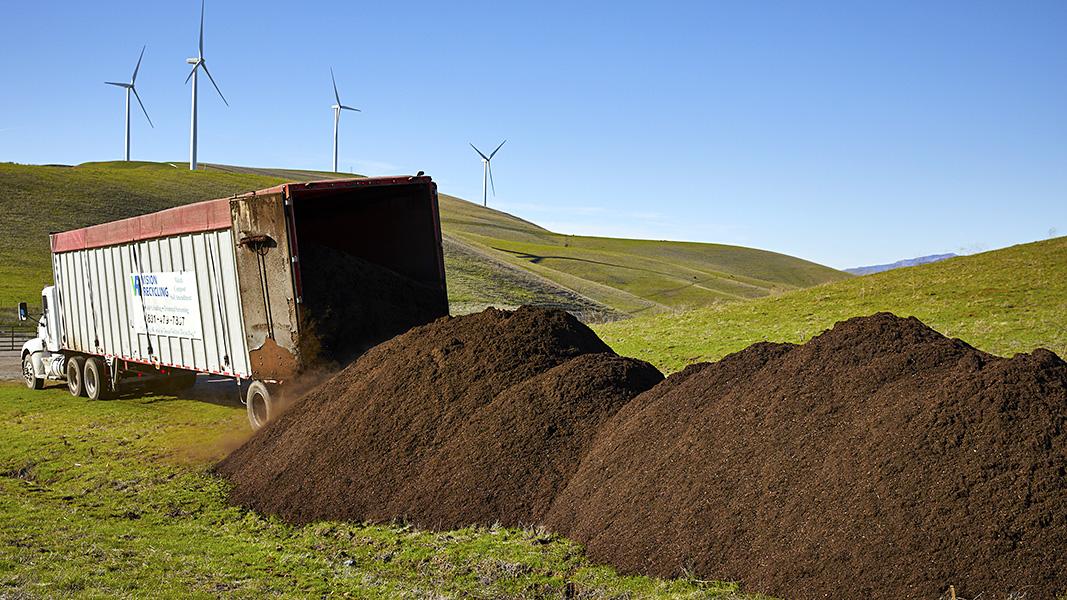Top: Demonstration project applied compost to rangeland to help engage agricultural producers in soil carbon sequestration practices. Photo courtesy of Alameda County Resource Conservation District
The California Air Resources Board (CARB) released its Scoping Plan 2022 Update on November 16, which will be considered by the Board on December 15. The update lays out the sector-by-sector roadmap for California to achieve carbon neutrality by 2045, setting a target of reducing anthropogenic emissions to 85% below 1990 levels. The Scoping Plan supports the integration of environmental justice to ensure that all communities will reap the benefits of this transformational plan. “What this means for California is an ambitious and aggressive approach to decarbonize every sector of the economy, setting us on course for a more equitable and sustainable future in the face of humanity’s greatest existential threat, and ensuring that those who benefit from this transformation include communities hardest hit by climate impacts and the ongoing pollution from the use of fossil fuels,” notes CARB in the Plan’s introduction. “The combustion of fossil fuels has polluted our air — particularly in low-income communities and communities of color — for far too long and is the root cause of climate change. This Scoping Plan helps us chart the path to a future where race and class are no longer predictors of disproportionate burdens from harmful air pollution and climate impacts.”
The Scoping Plan 2022 Update addresses re-envisioning California’s natural and working lands (NWL) for the first time “to ensure they play as robust a role as possible in incorporating and storing more carbon in the trees, plants, soil, and wetlands that cover 90% of the state’s 105 million acres while also thriving as a healthy ecosystem” says CARB. The California Compost Coalition (CCC) has been advocating for increased use of compost and biochar on the irrigated crop lands of California for over five years, and supports the California Department of Food and Agriculture’s Healthy Soils Initiative and its $75 million in grant funding that includes use of compost. “The Scoping Plan modeled various land management scenarios to help develop a target for California’s NWLs and provided an in-depth discussion on developing modeling scenarios for NWLs to sequester carbon,” according to an article in CCC’s November 2022 newsletter. “In consideration of the modeling scenarios, CCC has worked with other regenerative agriculture advocates to prepare a NWL Climate Change Implementation Plan that includes CCC metrics to ramp up compost and mulch use by 2030 and make compost application a priority. This made it into the Scoping Plan 2022 Update with targets of compost being applied to 31,000 to 62,000 acres each year to 2030, and mulching on crop land increasing from 10,400 to 20,800 acres per year.”
The Environmental Justice Advisory Committee (EJAC) — created by CARB to advise its scope planning — recommends including quantitative and qualitative targets around agricultural practices that would build environmental justice while addressing climate change, adds the CCC article. The EJAC prioritizes the following targets, goals and actions:
- Organic agriculture should make up 30% of the total agricultural acreage by 2030 and 80% by 2045.
- Reduce synthetic nitrogen (N) fertilizer use by 50% by 2030 through increasing N use efficiency and improving the use and distribution of compost, thus significantly reducing a major source of N in ground and surface waters, including drinking water sources, and methane emissions from landfills.
- Reduce synthetic pesticide use by 50% by 2030.













